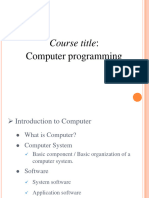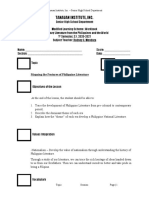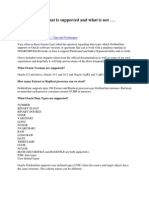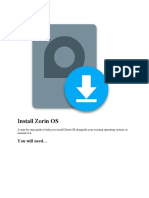SHS CSS 2 Programming - Week 04
Uploaded by
Rodney MendozaSHS CSS 2 Programming - Week 04
Uploaded by
Rodney MendozaK to 12 Basic Education Curriculum
Technical Vocational Livelihood Education
PROGRAMMING LANGUAGES (CSS 2)
Number of Sessions (Time Allotment): 60 Hours (1st Quarter)
INTRODUCTION TO PROGRAMMING CONCEPTS
SUMMARY OF LEARNING OUTCOMES (LO):
➢ LO 01: Software Concepts
➢ LO 02: Software Basics
➢ LO 03: Software Development Life Cycle (SDLC)
TANAUAN INSTITUTE, INC.
Senior High School Department
Modified Learning Scheme: Workbook
PROGRAMMING LANGUAGES (CSS 2)
1st Semester, S.Y. 2020-2021
Subject Teacher: LORENA A. AVILLANOZA
Name: ___________________________________ Score: ________________
Section: __________________________________ Date: _________________
Module 03: INTRODUCTION TO PROGRAMMING CONCEPTS
Topic : Lesson 01: Software Concepts Session :
Lesson 02: Software Basics WEEK 04
Lesson 03: Software Development Life Cycle 4 hrs.
Objectives of the Lesson :
At the end of the lesson, the student should be able to:
• Differentiate application software from system software,
• Define what SDLC is and recognize its importance, and
• Identify the different phases of SDLC.
Values Integration:
Nowadays, animation is already a large part of daily life-from games in gadgets to mainstream
movies, they are anywhere, However, a few decades ago, animation is very limited. Animation came a long way
before getting to gadgets, televisions and big screens. The industry of animation began less than 150 years ago,
but it has developed into multiple platforms and became very accessible to everyone.
Today, animation plays a big part in multimedia content. Animation can be used to strengthen all special effects
in motion picture and productions or to create a whole movie by itself. It comes anywhere and it can go anywhere
from a large production team working in a highly specialized studio to an individual who’s working out on a
bedroom from the big cinema screen or to a mobile phone.
PROGRAMMING LANGUAGES (CSS 2) / LORIE AVILLANOZA 1
Questions
1. What are the Importance of Application software?
2. What are the major contributions of SLDC Nowadays?
3. What are some rules that you think must be followed when creating a program?
Discussion :
Lesson 01: SOFTWARE CONCEPTS
WHAT IS A SOFTWARE?
• Computer instructions or data
• Anything that can be stored electronically
Computer programs, modules (support and data) working together providing computers with
instructions and data for certain task (e.g. word processing, internet browsing)
Software is defined as a program or set of instructions that tells the computer what to do.
Computer programmers write these instructions, using various programming languages
such as C++ and Java, to tell the computer hardware to perform specific tasks. Examples of software are
Apple OS for a Macintosh, or Windows 98 or Windows XP for a PC, the games we play or the tools we
use to compose letters or do math problems.
Lesson 02: SOFTWARE BASICS
• Computer Program (or “program”)
an organized list of instructions that, when executed, causes the computer to behave in a
predetermined manner.
• Support module
an auxiliary set of instructions used in conjunction with the main software program
PROGRAMMING LANGUAGES (CSS 2) / LORIE AVILLANOZA 2
• Data module
contains data (not supplied by the user) necessary for the execution of certain task.
Computer program (or “program”) - an organized list of instructions that, when executed, causes the
computer to behave in a predetermined manner. Without programs, computers are useless.
Support module – an auxiliary set of instructions used in conjunction with the main software program
(example: dynamic link libraries).
Data module – contains data (not supplied by the user) necessary for the execution of certain tasks.
Data modules have a variety of extensions like .dat, .hlp, and.text. Support modules often have .dll
extensions. Program files have .exe extensions.
The examples presented in the slide are eula.txt which is a data module, npwmsdrm.dll which is a
data module, npwmsdrm.dll which is a support module, and setup_wm.exe which is a program file.
Data vs. Software
Before, the term “software” is always associated to all non-hardware components of a computer.
However, modern definitions made it clear that all documents, spreadsheets and even downloaded
materials from the net are now classified as data.
Sometimes, the term “software” is used too loosely and could cause confusion. Before, the term
“software” is always associated to all non-hardware components of a computer. However, modern
definitions make it clear that all documents, spreadsheets, and even downloaded materials from the
internet are now classified as data which means that not all non-hardware components of a computer
are classified as software.
PROGRAMMING LANGUAGES (CSS 2) / LORIE AVILLANOZA 3
• Source code - code written by the programmer
• Object code - machine language representation of the source code
• Linker - creates the executable code, combines program object code, object code from library
routines and any other required system code into one addressable machine language file.
In computer science, code generation is a compilation stage that outputs machine code in the target
language. Code can appear in a variety of forms. The code that a programmer writes is called source
code. After it has been compiled, it is called object code. Code that is ready to run is called executable
code or machine code.
Initially, a programmer writes a program in a particular programming language. This form of the
program is called the source program, or more generically, source code. To execute the program,
however, the programmer must translate it into machine language, the language that the computer
understands. The first step of this translation process is usually performed by a utility called a compiler.
The compiler translates the source code into a form called object code. Sometimes, the object code is the
same as machine code; or sometimes it needs to be translated into machine language by a utility called
an assembler.
Application Software vs. System Software
• Application software - are computer programs that are used to accomplish specific or specialized
tasks for computer users.
• System software - helps the computer carry out its basic operating functions.
• Software is basically categorized into two: application software and system software.
Application software are computer programs used to accomplish specific or specialized tasks for
computer users such as creating and editing documents (word processing), making graphic
presentations, or listening to MP3 music. Examples of application software are word processors,
spreadsheets, accounting programs, graphics software, and games.
PROGRAMMING LANGUAGES (CSS 2) / LORIE AVILLANOZA 4
• System software are programs that control the basic operations of a computer system such as saving
files in a storage device like a hard disk or floppy disk, printing files, accepting input from a
keyboard or mouse, execute programs, etc.
Examples of system software include operating systems, communications control programs,
interpreters, compilers, debuggers, text editors, linkers, and loaders.
JAVA NETBEANS COMPILER
• Computer User - instructs the application program to print a document.
• Application Software - makes a request to the system software to print the document.
• System Software – controls the printer as the document is printed.
Computer User
computer user instructs
the application program
to print a document
Application
Software
(Microsoft Word)
application software
makes a request to the
system software to print
the document
System Software
(Operating System,
Device Drivers)
system software controls
the printer as the
document is printed
Hardware
(Computer, Printer)
PROGRAMMING LANGUAGES (CSS 2) / LORIE AVILLANOZA 5
Lesson 03: SOFTWARE DEVELOPMENT LIFE CYCLE
• SDLC is a methodology that is typically used to develop, maintain, and replace information systems
for improving the quality of the software design and development process.
• Importance of SDLC in order to create systems that are good in design it serves as a guide in
systems development.
• SDLC follows completion of logical sequence of stages/phases. The output of one stage becomes
input for the next stage.
In order to create systems with good design, we must take into consideration that it must involve several
phases. You can develop software in one big attempt.
Furthermore, it would be very favorable for companies to have certain set of standardized steps that
would serve as a guide in systems development.
SDLC involves five phases. Each phase plays an important role in creating a good system. The said
phases are:
Note that, implementing SDLC may involve several approaches. It is possible that other books may have
a more detailed explanation to the approach of SDLC. Our intention is just to have a basic, not
comprehensive, understanding of SDLC.
Five phases of SDLC
• Planning
• Analysis
• Design
• Implementation
• Maintenance
Planning Phase
Planning is the initial stage in the SDLC that has to be performed. This phase includes information about
the requirements for the proposed software. Also, this phase is known as the feasibility study phase.
• the initial stage in the SDLC that has to be performed
• includes the information about the requirements for the proposed software.
• known as the feasibility study phase
“In the first phase of the SDLC, the organization’s total information system needs are identified,
analyzed, prioritized, and arranged.”
For larger companies that deal with complicated software, it
is vital that these requirements are properly identified so that
the development of the software may not be delayed or
PROGRAMMING LANGUAGES (CSS 2) / LORIE AVILLANOZA 6
strayed from the original objective.
The purpose of the planning phase is to conduct a high-level
investigation of the business or project, and come up with a
recommendation for the solution.
Analysis Phase
The Analysis phase requires the analyst to thoroughly study the current procedures or software used to
execute tasks in an organization.
The main goal in this phase is to identify the requirements for new software or simply change several
aspects in the current working software.
The purpose of this phase is to conduct a detailed analysis of the project or current business needs, and
identify what options are available to achieve the needs.
• Requires the analyst to thoroughly study the current procedures or software used to execute tasks in
an organization.
• The main goal in this phase is to identify the requirements for a new software or simply change
several aspects in the current working system.
The activities performed by the analyst during this phase are:
1. Study the current software
2. Determine software requirements
3. Write requirements report
Design Phase
During the Design phase, the developer of the software translates the result of the previous phase into
actual design or specifications of the software.
Development of the software involves covering the input and output screens to reports, databases, and
computer process.
The purpose of this phase is to identify and document a solution that will be constructed according to
technical and procedural specifications. Design document will be created that should include but not
limited to technical, environmental, data, program, procedural, and testing specifications.
The activities performed in this phase are:
1. Identify potential solutions
2. Evaluate solutions and select the best
3. Select hardware and software
4. Develop application specifications
5. Obtain approval to implement the new software
PROGRAMMING LANGUAGES (CSS 2) / LORIE AVILLANOZA 7
Implementation Phase
After the design phase, we must put the proposed software into the test. During this phase, implementing
the software will include several steps:
• Coding – creation of the actual program
• Testing – both programmer and analyst submits the software to various “quality testing” to discover
if there are any bugs within the software.
• Installation - after coding and testing is done, the actual software must be installed and slowly or
completely replaces the old software.
The purpose of the implementation phase is to release a fully tested and operational product to an end
user or customer. The product should meet all the requirements.
Maintenance Phase
With every phase being completed, perhaps the maintenance phase would be the most prevalent phase of
all. There are some bugs in the software which can’t be properly identified without putting the software
into actual use.
This is where the software is systematically repaired and improved based on errors or possible new
requirements found.
• used to make necessary patches to remove found errors.
• where the software is systematically repaired and improved based on errors or possible new
requirements found.
Suggests that prior to proceeding to next phase, the current phase should be finished first.
• Waterfall SDLC - the waterfall SDLC suggests that prior to the next phase, the current phase
should be finished first. But applying this strategy in the real world would be unfeasible since it
would be impossible to modularize system development.
PROGRAMMING LANGUAGES (CSS 2) / LORIE AVILLANOZA 8
• Modified waterfall - this version of the SDLC is more flexible compared to the traditional SDLC
model. Since the nature of developing software is unpredictable, using this model will allow the
developer to adjust to certain situations, such as unforeseen requirements, or additional features that
are highly needed in the software.
allows overlap between phases.
PLANNING
ANALYSIS
DESIGN
IMPLEMENTATION
MAINTENANCE
Iterative SDLC
ANALYZE ANALYZE
PLANNING MAINTAIN SYSTEM
DESIGN DESIGN
IMPLEMENT IMPLEMENT
This version of the SDLC is more flexible compared to the traditional SDLC model. Since the nature of
developing software is unpredictable, using this model will allow the developer to adjust to certain
situations, such as unforeseen requirements, or additional features that are highly needed in the software.
Activity :
ACTIVITY 1: Converting Binary codes:
At the end of the exercise, the students should be able to:
• learn more about Binary.
• familiarize with the rules and regulations in using the Binary.
Materials:
-Pen -A sheet of paper
PROGRAMMING LANGUAGES (CSS 2) / LORIE AVILLANOZA 9
References :
• Department of Technology Education at The University of Southern
Mississippi. (2007, February 26). Retrieved from
Dragon.ep.usm.edu/~it365/module/Basics/system.htm
• Hoffer J., George G., & Valacich J. (2008). In 5 Ed., Modern systems
analysis and design. Pearson Prentice Hall.
• Parsons J. J., & Oja D. (2010). In 8 Ed., Computer concepts Illustrated
Introductory. Cengage Learning.
PROGRAMMING LANGUAGES (CSS 2) / LORIE AVILLANOZA 10
You might also like
- What Men Dont Want Women To Know - The Secrets, The Lies, The Unspoken Truth - Smith and Doe90% (20)What Men Dont Want Women To Know - The Secrets, The Lies, The Unspoken Truth - Smith and Doe157 pages
- Dangerous Google - Searching For Secrets PDF88% (26)Dangerous Google - Searching For Secrets PDF12 pages
- How To Download Documents From Scribd For Free - 7 Methods67% (9)How To Download Documents From Scribd For Free - 7 Methods25 pages
- Knowledge Matters Virtual Business Quiz Answers0% (2)Knowledge Matters Virtual Business Quiz Answers7 pages
- How To Disappear - Erase Your Digital Footprint, Leave False Trails, and Vanish Without A Trace PDF100% (3)How To Disappear - Erase Your Digital Footprint, Leave False Trails, and Vanish Without A Trace PDF111 pages
- Instant Download Technology in Action Introductory 13th Edition Alan Evans PDF All Chapter100% (8)Instant Download Technology in Action Introductory 13th Edition Alan Evans PDF All Chapter53 pages
- 6th Central Pay Commission Salary Calculator100% (436)6th Central Pay Commission Salary Calculator15 pages
- Lecture Note 1. Introduction To Computer and ProgrammingNo ratings yetLecture Note 1. Introduction To Computer and Programming45 pages
- 73L DI Turbo Diesel - 1997 - Engine Circuits Federal100% (3)73L DI Turbo Diesel - 1997 - Engine Circuits Federal3 pages
- GET214 Lesson0 - Introduction to ComputingNo ratings yetGET214 Lesson0 - Introduction to Computing6 pages
- Continued On EEE211 (Electrical Engineering CourseNo ratings yetContinued On EEE211 (Electrical Engineering Course23 pages
- Topic 1 - Introduction To Computers and Programming PDFNo ratings yetTopic 1 - Introduction To Computers and Programming PDF37 pages
- COMPUTATIONAL PHYSICS PROGRAMMING SHAHBAZ BHATTI Lecture 01No ratings yetCOMPUTATIONAL PHYSICS PROGRAMMING SHAHBAZ BHATTI Lecture 0126 pages
- Indian Desi Coder: Basic Information About ProgrammingNo ratings yetIndian Desi Coder: Basic Information About Programming19 pages
- Introduction To Computer and ProgrammingNo ratings yetIntroduction To Computer and Programming45 pages
- (TIC 02) Detailed Lesson Plan (AutoRecovered)No ratings yet(TIC 02) Detailed Lesson Plan (AutoRecovered)5 pages
- Rogramming for Problem Solving Using c Me Lecture NotesNo ratings yetRogramming for Problem Solving Using c Me Lecture Notes118 pages
- Software Suite: Revolutionizing Computer Vision with the Ultimate Software SuiteFrom EverandSoftware Suite: Revolutionizing Computer Vision with the Ultimate Software SuiteNo ratings yet
- (M2-MAIN) Introduction To Computer and Programming ConceptsNo ratings yet(M2-MAIN) Introduction To Computer and Programming Concepts50 pages
- Overview of Programming: CSE115: Computing ConceptsNo ratings yetOverview of Programming: CSE115: Computing Concepts21 pages
- Visual Basic Lesson 1 - Introduction To Computer ProgrammingNo ratings yetVisual Basic Lesson 1 - Introduction To Computer Programming22 pages
- ICS 2102 Lecture 1 Hardware and Software BasicsNo ratings yetICS 2102 Lecture 1 Hardware and Software Basics38 pages
- FUNDAMENTALS OF SOFTWARE_Excel_2013_2014-1No ratings yetFUNDAMENTALS OF SOFTWARE_Excel_2013_2014-143 pages
- inf1030-01-introduction-to-computing-and-application-developmentNo ratings yetinf1030-01-introduction-to-computing-and-application-development105 pages
- (O'SMART) ELE 276 Lecture Notes-CompressedNo ratings yet(O'SMART) ELE 276 Lecture Notes-Compressed223 pages
- CC101 Computer Programming 1 FundamentalsNo ratings yetCC101 Computer Programming 1 Fundamentals130 pages
- Understanding Computer Programming 9&10No ratings yetUnderstanding Computer Programming 9&1053 pages
- 1 ICS 2175 Lecture 2 Intro To Algo To Use1No ratings yet1 ICS 2175 Lecture 2 Intro To Algo To Use157 pages
- Low Level Assembly Lang., Machine CodesNo ratings yetLow Level Assembly Lang., Machine Codes10 pages
- An Embodied Spirit Coexsisting With The Environment: Unit IiNo ratings yetAn Embodied Spirit Coexsisting With The Environment: Unit Ii82 pages
- Reading and Writing - Preliminary Exam (Mga Tugon)No ratings yetReading and Writing - Preliminary Exam (Mga Tugon)18 pages
- Programming Languages (Css 2) : Number of Sessions (Time Allotment) : 60 Hours (2nd Quarter)No ratings yetProgramming Languages (Css 2) : Number of Sessions (Time Allotment) : 60 Hours (2nd Quarter)14 pages
- 10 Useful Websites You Wish You Knew Earlier! 6 (2017)0% (1)10 Useful Websites You Wish You Knew Earlier! 6 (2017)21 pages
- HEALTH CARE POWER OF ATTORNEY (SC Statutory Form)No ratings yetHEALTH CARE POWER OF ATTORNEY (SC Statutory Form)7 pages
- Black & Decker The Complete Outdoor Builder100% (11)Black & Decker The Complete Outdoor Builder529 pages
- COMPUTER REPAIR Smartiepants - F - Ken Jaskulski83% (6)COMPUTER REPAIR Smartiepants - F - Ken Jaskulski330 pages
- Apply Rolling PSU Patch in Oracle Database 12c RAC EnvironmentNo ratings yetApply Rolling PSU Patch in Oracle Database 12c RAC Environment6 pages






















































































































